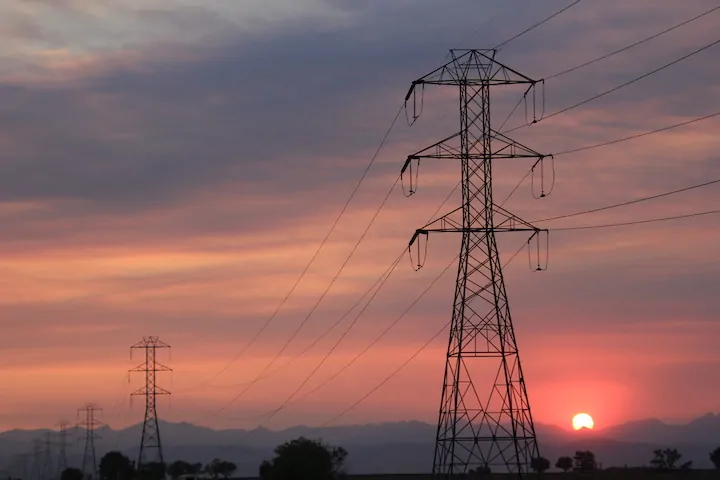
Transmission towers are silhouetted against the setting sun. Photo by Allen Best.
Tri-State Generation, the cooperative power supplier to electric cooperatives and public power districts throughout the West (including as the energy generation provider for Sangre de Cristo Electric Association) announced this morning that it has filed its 2023 Electric Resource Plan. In cooperation with the Transmission Association, the plan lays out a transition on an accelerated timeframe to acquire more affordable clean energy power supplies while bolstering electric system reliability.
The long-term strategic plan has been endorsed by key stakeholders including Tri-State members, environmental non-governmental organizations, state agencies and industry groups that contributed to the plan.
At the heart of the ambitious resource plan is a two-fold strategy: electric system resilience and reduced costs. It anticipates 1,250 megawatts of additional renewables and battery storage to be procured through 2031.
The plan lays out increased operations costs and reduced member loads, that will drive retirement of its Craig Station by the end of 2028 (relying on some federal funding) and retirement in 2031 of Tri-State’s Springerville Station Unit 3.
Plan to Benefit a Four-State Benefit Area
Tri-State notes that to expects rural electricity consumers across four western states will benefit from reliable power and lower costs, with clean energy investment and greenhouse gas emissions reductions accelerated by federal funding.
The not-for-profit wholesale power supply cooperative’s 2023 Electric Resource Plan (ERP), filed with the Colorado Public Utilities Commission (CoPUC), includes as its preferred plan an Inflation Reduction Act (IRA) scenario that would be enabled by funding through the U.S. Department of Agriculture’s (USDA’s) Empowering Rural America (New ERA) program.

A Tri-State natural gas peaker plant. Courtesy photo.
“Our ambitious plan, with federal funding, can accelerate clean energy investment and significant greenhouse gas emissions reductions at a lower cost than alternative scenarios, all while exceeding both industry-standard and heightened extreme weather reliability criteria,” said Tri-State CEO Duane Highley.
“We are clearly demonstrating how Tri-State remains the most reliable, affordable and responsible power supplier for our members both now and well into the future,” he added.
Tri-State is a power supply cooperative of 45 members, and it operates on a not-for-profit basis. This includes 42 utility electric distribution cooperatives and public power district members in four states (New Mexico, Colorado, Nebraska and Wyoming), covering nearly 200,000 square miles of the West. Visit www.tristate.coop.
Tri-State’s preferred plan identifies these key elements:
- The addition of 1,250 megawatts (MW) of new renewable energy resources and energy storage through 2031
- The retirement of Craig Station in 2028
- The addition of a dispatchable natural gas unit in 2028 with carbon capture and sequestration added in 2031
- The retirement of Springerville Unit 3 in 2031.
- With sufficient federal funding support, the plan results in accelerated systemwide emissions reductions and an 89 percent reduction in greenhouse gas emissions in Colorado by 2030, relative to a 2005 baseline.

Colorado solar panels. Image courtesy of Pivot Energy.
“Our rapid transition increases clean energy used by our members to 50 percent in 2025 and 70 percent by 2030, benefiting members with lower and stable priced renewable energy resources,” said Highley. “Through 2043, our plan reduces costs to our members by more than $1.8 billion compared to business as usual.”
The investments in Tri-State’s preferred plan are contingent on approval by the CoPUC and a New ERA award from the USDA. “Federal funding in support of our preferred plan would be transformational for Tri-State and our members,” said Highley.
Tri-State will invest in the largest resource acquisition in its history, including 1,250 MW of geographically distributed renewables and battery storage between 2026 and 2031, including:
500 MW of wind resources;
200 MW of wind resources with storage hybrids;
310 MW of storage, including standalone 100-hour iron air batteries, standalone 4-hour batteries, and 4-hour batteries with wind and storage hybrids; and 240 MW of solar resources.
These resources will be procured as a mix of power purchase agreements and owned resources. In addition to these resources, Tri-State is adding 595 MW of new solar resources in 2024 and 2025 that were previously announced in 2020, bringing a total of 920 MW of solar resources on Tri-State’s system by 2031. In 2031, Tri-State will have a total of 1,374 MW of wind resources.
Craig Station and Springerville Unit 3 retire, natural gas plant with carbon capture supports resilience
With resource costs increasing and Tri-State’s load reduced from three member systems terminating their contracts to withdraw from membership between 2024-2025, all of the scenarios modeled retire Craig Station Unit 3 by Jan. 1, 2028, to improve system economics. The retirements of Craig Station Unit 1 by Dec. 31, 2025, and Craig Station Unit 2 by Sept. 30, 2028, were previously announced.
Craig Station Units 1 and 2 are jointly owned by Xcel Energy, Platte River Power Authority, Salt River Project, PacifiCorp, and Tri-State. Tri-State owns Unit 3.
“The benefits of federal funding would help us to address the stranded costs of retiring coal units, ensuring lower emissions while protecting rural consumers from increased costs,” said Highley. “With our local, state and federal partners, we will continue to work with our employees and the northwest Colorado community to support their transition.”
With federal funding to reduce greenhouse gas emissions, and offset closure and stranded asset costs, Tri-State’s preferred plan proposes a retirement date of the Arizona-based Springerville Station Unit 3 by Sept. 15, 2031, pending CoPUC approval of Phase 1 of the 2023 ERP filing. The early retirement date of Springerville Station 3 would largely be due to economic factors.
To meet industry-standard Level 1 reliability metrics and Tri-State’s heightened extreme weather Level 2 reliability metrics, the preferred plan adds a 290 MW combined-cycle natural gas unit in 2028, with carbon capture and sequestration added in 2031. The dispatchable power plant balances renewable resources to ensure reliability and is forecasted to operate with a low capacity factor until carbon capture and sequestration is operational.
System-wide emissions reductions include 89 percent greenhouse gas reduction in Colorado by 2030
Tri-State says that to be responsive to the New ERA Program’s criteria prioritizing GHG reductions through 2031, its preferred plan will both “reliably and ambitiously reduce emissions across its system”, including reducing emissions associated with Colorado wholesale electricity sales. It projects a reduction of 89 percent in emissions by 2030, relative to a 2005 baseline, exceeding the state’s emissions reduction requirements.
“With federal funding, we can further reduce greenhouse gas emissions and avoid new emissions while increasing our renewables mix and reducing carbon intensity,” said Highley.
Energy efficiency and demand management meet state targets
Tri-State has run energy efficiency and demand management scenarios; all of these ERP scenarios include Colorado energy efficiency targets and a Colorado demand response target of four percent beginning in 2025. Tri-State also identifies energy efficiency and demand response in New Mexico and Wyoming.
“Tri-State’s Cooperative Energy Ecosystem includes a Distributed Energy Resource Management System that will optimize loads and resources with our member systems to increase resilience and lower costs,” said Highley.
Strong stakeholder support for acquisitions and retirements advanced by potential New ERA award
“This transformational plan outlines the most cost-effective path for Tri-State to meet our mission to serve our members with a reliable, affordable, and responsible supply of electricity,” said Highley. “We look forward to continuing to work with our members, the Colorado Public Utilities Commission, and stakeholders on a reliable, affordable, and responsible path forward that meets our members’ needs and accomplishes our energy transition goals.”
In addition, certain components of Tri-State’s preferred plan are supported by a Stipulation that requests that the CoPUC approve certain elements of the scenario and commit to support the acquisitions and retirements for which a New ERA award is being sought. The Stipulation was reached with Tri-State members Mountain View Electric Association and Otero County Electric Cooperative, the Colorado Energy Office, Colorado Utility Consumer Advocate, Colorado Solar and Storage Association, Western Resource Advocates and the Sierra Club.
“Tri-State’s plan leverages potential federal funding to accelerate their transformation at the lowest cost and greatest reliability,” said Ruth Marks, CEO of Tri-State member Mountain View Electric Association (Limon, Colo.). “Importantly, Tri-State included opportunities for its members from each state to participate in a collaborative resource planning process.”
“We appreciate Tri-State’s commitment to decarbonization and are excited to see the benefits of more low-cost clean energy that the New ERA program can deliver for electric cooperative members and rural communities across our state,” said Colorado Energy Office Executive Director Will Toor.
“The proposed plan builds on the commitments Tri-State made in its 2020 electric resource plan to reduce greenhouse gas emissions for its Colorado members,” said Western Resource Advocates Deputy Director of Policy Development Stacy Tellinghuisen. “We commend Tri-State for developing a plan that ensures all its member cooperatives benefit from the transition to clean energy, and we encourage other utilities to tap into these critical federal funds to replace their expensive, polluting plants with cleaner resources.”
“We strongly support Tri-State’s proposal to make smart use of federal funding to bring the benefits of low-cost clean energy to its rural members,” said Sierra Club Colorado Field Manager Sarah Clark. “Tri-State’s plan to accelerate its transition away from coal and toward cleaner energy resources is a win-win, as it would both reduce emissions and save customers money. We encourage the USDA to approve Tri-State’s federal funding request to advance this transformational plan.”
This isn’t completely final yet: the electric resource plan is subject to review, modification, and approval by the CoPUC, and input by intervenors, and it is subject to change depending on a New ERA award, and new technologies and regulatory landscape could come into play. Tri-State says it will adjust its plan as needed based on these changes as they occur. Phase II of the 2023 ERP will reflect relevant changes next year.







Recent Comments